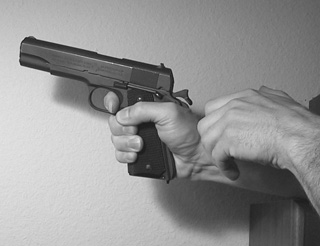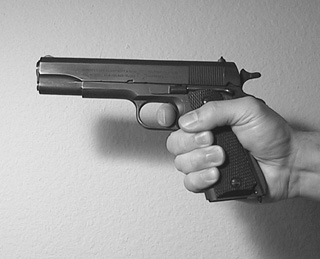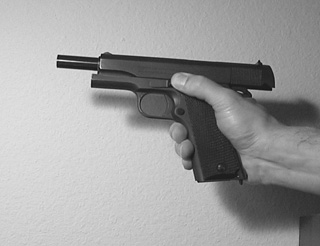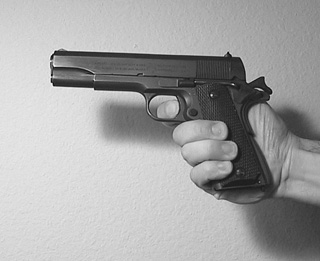Safety/Function Checking a 1911The following steps are necessary when evaluating any M1911-type pistol that you plan on purchasing, in order to verify that the pistol is in safe working condition. Even if you have no plans to ever shoot the pistol, by verifying the working condition of the gun you will get an idea as to its true condition, and also feel assured that you are buying a real working firearm and not just an expensive paperweight. If the pistol fails these safety checks and you plan on purchasing it anyway, you MUST either have it repaired by a competent pistolsmith or else make sure that live ammunition is never fired in the pistol. Either find a tasteful way to mark it as being "not safe to fire", or else disable the firing mechanism completely.
It should also be understood that merely passing these safety checks does NOT guarantee that the pistol in question is safe to fire. Due to other factors such as improper headspace, metallurgical flaws, etc. it is still necessary to have a pistolsmith check the firearm over before firing live ammunition in it. These safety checks are merely for your use at the time of sale, in order to do a quick verification that there is nothing seriously wrong with the pistol. Once again, have a pistolsmith check over ANY used gun you buy before taking it to the range!
DO NOT ATTEMPT THESE CHECKS UNTIL AFTER YOU HAVE MADE ABSOLUTELY CERTAIN THAT THE GUN IS UNLOADED.
SAFETY FIRST: DO NOT attempt any of the following safety checks until you have made ABSOLUTELY certain that the gun is unloaded! Point the gun is a safe direction, then:
1. FIRST completely remove the magazine.
2. Lock the slide back, engaging the slide stop.
3. LOOK into the chamber to ensure that no live round is present. Feel into the chamber with the tip of your little finger if you have to.
Even after verifying that you are holding an unloaded gun, always keep the pistol pointed in a safe direction while performing the following tests.
===================================================

BASIC TEST: Slide forward, hammer cocked, thumb safety off, holding pistol normally with firing hand. Pull trigger- hammer should fall.
===================================================

FUNCTIONING TEST: Still holding gun in the firing hand, leave trigger pressed and pull slide back.
===================================================

Release slide, keeping trigger pressed. Hammer should now be fully cocked. Release trigger, then pull it again. Hammer should fall.
==================================================

HALF-COCK TEST: Using thumb, pull hammer back until the first audible click. Hammer should be at half-cock notch. Grip gun normally, attempt to pull trigger. Hammer should NOT fall for any reason, unless the gun is a Series 80 commercial. These guns have a re-designed half-cock notch that engages near the at-rest position, thus the hammer cannot fall hard enough to strike the firing pin with force. MILITARY GUNS WILL ALWAYS USE THE OLDER HALF-COCK NOTCH, WHICH SHOULD NEVER ALLOW THE HAMMER TO FALL.
==================================================

SEAR ENGAGEMENT TEST: Lock the slide back, grip gun normally, then release the slide stop, allowing slide to slam home with force. The hammer should NOT fall for any reason. If it does then the hammer/sear engagement is too weak. Repeat test once again to be sure.
Note: The gun's current owner may not appreciate seeing the slide being slammed home on an empty chamber in this fashion, even though it is a critical safety check. Tell the owner what you intend to do beforehand and why, and limit it to one or two attempts.
==================================================

THUMB SAFETY CHECK: Holding gun normally with firing hand, slide forward, hammer cocked, thumb safety ON. Attempt to pull trigger. The hammer should not fall, nor should you feel any perceptible movement of internal parts. If you squeezed the trigger and it didn't come to a quick, hard stop (i.e. the trigger felt mushy) then there may have been some sear movement.
Release trigger, disengage thumb safety. Hammer still should not fall. If it does the thumb safety and/or sear is faulty.
=================================================

GRIP SAFETY TEST: Hammer cocked, slide forward, thumb safety OFF. Hold the gun so as to not depress the grip safety. Attempt to pull trigger. Hammer should not fall. If it does the grip safety is worn or has been deactivated.
=================================================

DISCONNECTOR TEST: Slide forward, hammer back, thumb safety OFF. Grip gun normally with firing hand, while pulling slide back 1/4" with support hand. Pull trigger. Hammer should not fall. Repeat test by pulling slide all the way back, then releasing it slowly, pulling trigger every 1/2" of slide movement. The hammer should NOT fall until the slide has returned to the full forward position. If it does then the disconnector is worn. DO NOT fire the pistol until it is repaired, or else it may possibly go into firing uncontrollable bursts or go completely "full-auto".
--courtesy of coolgunsite.com
